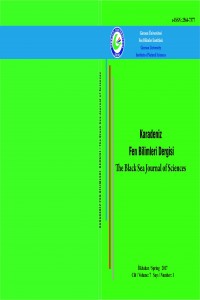Abstract
If
power quality can be maintained, high performance is possible for electrical
devices. Harmonics is one of such problems that can cause performance to drop.
Therefore, harmonics must be detected and prevented. This study aimed to be
part of detection system designed to maintain power quality. Akaike Information
Criterion is used to calculate features for power quality analysis. And for
classification k-Nearest Neighbor classification is used. %94.8 accuracy is
obtained from training set and %91.7 accuracy is obtained from test set. MATLAB
is the program which is used for classification and feature calculation.
References
- Chattopadhyay, S., Mitra, M., Sengupta, S., (2011). Electric Power Quality. Springer Science+Business. ISBN 978-94-007-0634-7.
- Lin, H. C., Lee. C. S. (2001). "Enhanced FFT-based parametric algorithm for simultaneous multiple harmonics analysis." IEE Proceedings-Generation, Transmission and Distribution 148.3: 209-214.
- Qian, H., Rongxiang Z., Tong C., (2007). "Interharmonics analysis based on interpolating windowed FFT algorithm." IEEE Transactions on Power Delivery 22.2: 1064-1069.
- Huang, C., Ya-qun J., (2005). "Improved window and interpolation algorithm for analysis of power system harmonics." Zhongguo Dianji Gongcheng Xuebao(Proc. Chin. Soc. Electr. Eng.). Vol. 25. No. 15.
- Zhan, Y., et al. (2004). "A Robust Support Vector Algorithm for Harmonics Analysis of Electric Power System [J]." Proceedings of the Csee 12: 009.
- Qian Y., Wen, P., Zhou. E. (1994). "Power Harmonics Measurement Based on Windows and Interpolated FFT (Ⅱ) Dual Interpolated FFT Algorithms [J]."Transactions of China Electrotechnical Society 2 .
- Jiang, C., Min L., (2010). "Inter-harmonics analysis based on double interpolation FFT algorithm [J]." Power System Protection and Control 3
- Ganyun, D., Haozhong L., Lu R., Sun Y., Yifeng, C., Zhan Y., (2005) "Spectrum Estimation of Harmonics and Interharmonics Based on Prony Algorithm [J]." Transactions of China Electrotechnical Society 10: 018.
- Wang, G., Dong-yang X., Wei-ming M., (2008) "Improved algorithm for non-integer harmonics analysis based on FFT algorithm and neural network. "PROCEEDINGS-CHINESE SOCIETY OF ELECTRICAL ENGINEERING 28.4: 102.
- Henderson, R. D., Patrick J. R., (1994) "Harmonics: the effects on power quality and transformers." IEEE transactions on industry applications 30.3: 528-532.
- https://en.wikipedia.org/wiki/Harmonics_(electrical_power) (Erişim Tarihi: 29 Mart 2017).
- Burnham, K.P., David R. A., (1998) "Introduction." Model Selection and Inference. Springer New York,. 1-31.
- https://www.mathworks.com. (Erişim Tarihi: 29 Mart 2017).
- http://en.wikipedia.org/wiki/Sensitivity_and_specificity (Erişim Tarihi: 29 Mart 2017).
Abstract
Elektrik kalitesi korunabiliyorsa, elektrikli
cihazlar için yüksek performans mümkündür. Harmonikler, performans düşmesine
neden olan bu tür sorunlardan biridir. Bu nedenle, harmonikler tespit edilmeli
ve engellenmelidir. Bu çalışma, güç kalitesini korumak için tasarlanan algılama
sisteminin bir parçası olmayı amaçlamıştır. Akaike Bilgi Kriteri, güç kalitesi
analizi için özellikleri hesaplamak için kullanılır. Ve sınıflandırma için k-En
Yakın Komşu sınıflandırması kullanıldı. Eğitim setinden% 94.8 doğruluk elde
edilmiştir ve Test setinden% 91.7 doğruluk elde edilmiştir. MATLAB,
sınıflandırma ve özellik hesaplama için kullanılan programdır.
References
- Chattopadhyay, S., Mitra, M., Sengupta, S., (2011). Electric Power Quality. Springer Science+Business. ISBN 978-94-007-0634-7.
- Lin, H. C., Lee. C. S. (2001). "Enhanced FFT-based parametric algorithm for simultaneous multiple harmonics analysis." IEE Proceedings-Generation, Transmission and Distribution 148.3: 209-214.
- Qian, H., Rongxiang Z., Tong C., (2007). "Interharmonics analysis based on interpolating windowed FFT algorithm." IEEE Transactions on Power Delivery 22.2: 1064-1069.
- Huang, C., Ya-qun J., (2005). "Improved window and interpolation algorithm for analysis of power system harmonics." Zhongguo Dianji Gongcheng Xuebao(Proc. Chin. Soc. Electr. Eng.). Vol. 25. No. 15.
- Zhan, Y., et al. (2004). "A Robust Support Vector Algorithm for Harmonics Analysis of Electric Power System [J]." Proceedings of the Csee 12: 009.
- Qian Y., Wen, P., Zhou. E. (1994). "Power Harmonics Measurement Based on Windows and Interpolated FFT (Ⅱ) Dual Interpolated FFT Algorithms [J]."Transactions of China Electrotechnical Society 2 .
- Jiang, C., Min L., (2010). "Inter-harmonics analysis based on double interpolation FFT algorithm [J]." Power System Protection and Control 3
- Ganyun, D., Haozhong L., Lu R., Sun Y., Yifeng, C., Zhan Y., (2005) "Spectrum Estimation of Harmonics and Interharmonics Based on Prony Algorithm [J]." Transactions of China Electrotechnical Society 10: 018.
- Wang, G., Dong-yang X., Wei-ming M., (2008) "Improved algorithm for non-integer harmonics analysis based on FFT algorithm and neural network. "PROCEEDINGS-CHINESE SOCIETY OF ELECTRICAL ENGINEERING 28.4: 102.
- Henderson, R. D., Patrick J. R., (1994) "Harmonics: the effects on power quality and transformers." IEEE transactions on industry applications 30.3: 528-532.
- https://en.wikipedia.org/wiki/Harmonics_(electrical_power) (Erişim Tarihi: 29 Mart 2017).
- Burnham, K.P., David R. A., (1998) "Introduction." Model Selection and Inference. Springer New York,. 1-31.
- https://www.mathworks.com. (Erişim Tarihi: 29 Mart 2017).
- http://en.wikipedia.org/wiki/Sensitivity_and_specificity (Erişim Tarihi: 29 Mart 2017).
Details
| Subjects | Engineering |
|---|---|
| Journal Section | Articles |
| Authors | |
| Publication Date | June 15, 2017 |
| Published in Issue | Year 2017 Volume: 7 Issue: 1 |
 This work is licensed under a Creative Commons Attribution-NonCommercial-ShareAlike 4.0 International License.
This work is licensed under a Creative Commons Attribution-NonCommercial-ShareAlike 4.0 International License.


